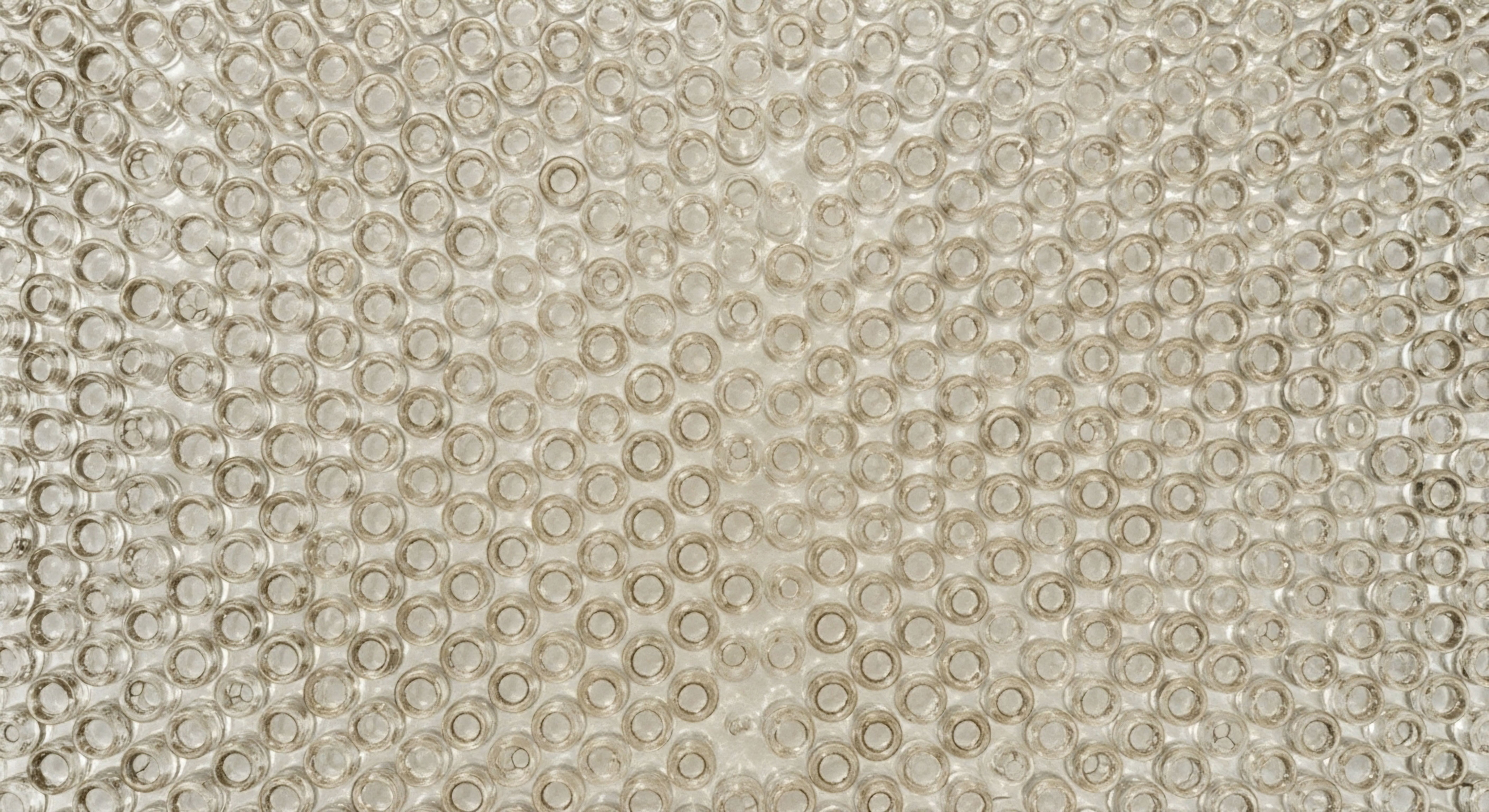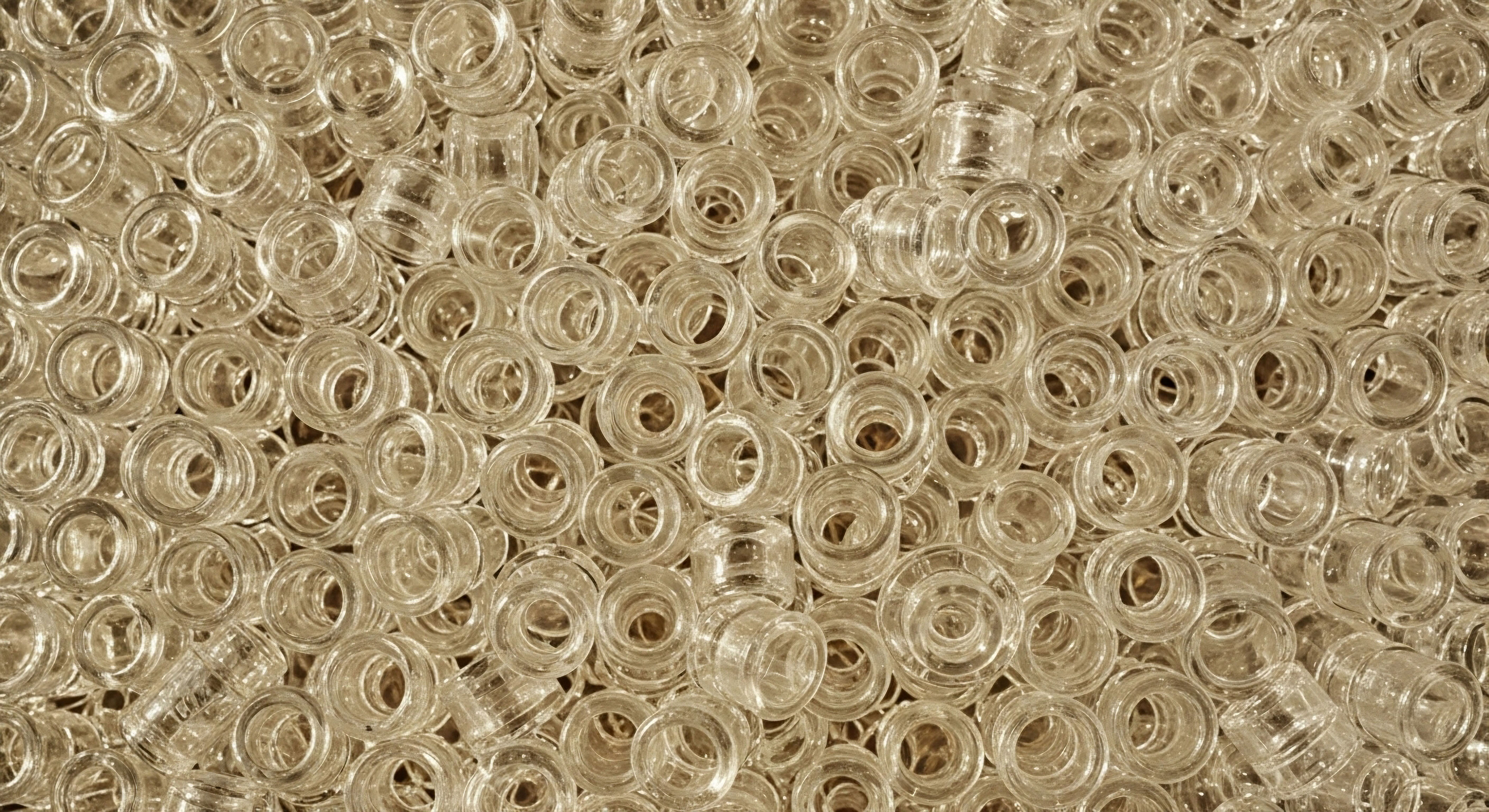

Fundamentals
You have begun a protocol to restore your systemic hormonal balance, and the benefits are likely becoming apparent. Your energy, your clarity of thought, your fundamental sense of well-being are returning to a level you may have thought was lost. This is a profound and validating experience.
Yet, a new consideration has presented itself, one that touches upon an equally fundamental aspect of your biology ∞ your fertility. The very therapy that revitalizes the man can, through its mechanism of action, suppress the biological process of fatherhood. You are right to ask what can be done, to seek a path that honors both your personal vitality and your procreative potential.
The conversation about sperm quality during testosterone therapy begins with understanding the body’s internal communication network, the Hypothalamic-Pituitary-Gonadal (HPG) axis. Think of this as a finely tuned command-and-control system. The hypothalamus in your brain sends a signal (GnRH) to the pituitary gland.
The pituitary, in turn, releases two key messenger hormones ∞ Luteinizing Hormone (LH) and Follicle-Stimulating Hormone (FSH). LH instructs the Leydig cells in the testes to produce testosterone. FSH signals the Sertoli cells, also in the testes, to support and mature developing sperm. The testosterone produced within the testes, known as intratesticular testosterone, is present at concentrations up to 100 times higher than in your bloodstream and is absolutely essential for sperm production, or spermatogenesis.
When you introduce testosterone from an external source, your brain’s sensitive monitoring system detects that circulating levels are sufficient. In response, the hypothalamus and pituitary dramatically reduce their output of GnRH, LH, and FSH. This down-regulation is the body’s natural way of maintaining equilibrium.
The consequence of this reduced signaling is that the testes’ own production of testosterone plummets. While your systemic levels are optimized, the all-important intratesticular concentration of testosterone falls, leading to a significant reduction or complete halt of sperm production. This is the central paradox you are facing.

The Cellular Environment of the Testes
Protecting fertility during hormonal optimization protocols requires a shift in focus from the systemic to the local. We must look at the specific environment within the testes where sperm are born, mature, and acquire their function. This is a world of delicate cellular machinery, highly susceptible to damage from a phenomenon known as oxidative stress.
Oxidative stress occurs when there is an imbalance between the production of reactive oxygen species (ROS), which are unstable molecules that can damage cells, and the body’s ability to neutralize them with antioxidants. Sperm cells are uniquely vulnerable. Their membranes are rich in polyunsaturated fatty acids, which are easily damaged by ROS, and they have very limited internal systems for repair.
Protecting sperm quality is fundamentally about controlling oxidative stress and providing the precise molecular resources needed for healthy sperm development.
Non-pharmacological methods are your tools to fortify this local environment. They work by supplying the body with the raw materials for its own defense systems and by reducing the systemic burdens that increase oxidative stress in the first place. These interventions are about creating a state of resilience at the cellular level, ensuring that even with the suppressive hormonal signals from TRT, the machinery of spermatogenesis is protected and supported to the greatest extent possible.

Foundational Lifestyle Adjustments
Before considering specific nutrients or supplements, the foundation of sperm health rests on broader lifestyle pillars. These elements collectively lower the body’s total oxidative load, creating a more favorable internal environment for all physiological processes, including spermatogenesis.
- Sleep Architecture ∞ Deep, restorative sleep is when the body undertakes critical repair processes and hormonal regulation. Chronic sleep deprivation disrupts the entire HPG axis and increases systemic inflammation and oxidative stress, directly impacting the testicular environment. Prioritizing 7-9 hours of quality sleep per night is a non-negotiable aspect of fertility support.
- Stress Modulation ∞ Psychological stress triggers the release of cortisol, a hormone that can directly suppress the HPG axis and reduce testosterone production. Chronic stress also generates a high level of systemic inflammation. Practices such as meditation, deep breathing exercises, or spending time in nature can tangibly lower cortisol levels and reduce the oxidative burden on your system.
- Physical Activity ∞ Moderate, consistent exercise improves circulation, enhances insulin sensitivity, and helps manage weight, all of which contribute to lower oxidative stress. However, excessive, high-intensity training can have the opposite effect, increasing ROS production and physical stress. Finding a sustainable balance is key.
- Weight Management ∞ Adipose tissue, or body fat, is metabolically active and produces inflammatory signals and estrogen through the action of the aromatase enzyme. Excess body fat is strongly linked to increased oxidative stress and impaired sperm parameters. Achieving and maintaining a healthy body composition is one of the most effective ways to improve the hormonal and metabolic environment for sperm production.
These lifestyle factors are the soil in which more targeted nutritional strategies can take root. They create the systemic conditions that allow for the optimal function of the testicular microenvironment, giving you a powerful set of tools to support your fertility goals while on your journey of hormonal optimization.


Intermediate
Understanding that testosterone therapy suppresses the hormonal signals for spermatogenesis is the first step. The next is to appreciate the direct biochemical consequences of that suppression and the specific ways non-pharmacological strategies can intervene. The challenge is to support a complex, multi-stage manufacturing process ∞ the creation of a healthy sperm cell ∞ without the primary top-down hormonal directive. This requires a bottom-up approach, focusing on providing optimal raw materials and protecting the cellular factory from environmental damage.
Spermatogenesis is a 74-day process of immense biological complexity. During this time, a simple germ cell undergoes profound transformation, developing a head containing tightly packaged DNA, a midpiece packed with energy-producing mitochondria, and a tail for motility.
Each of these components is a potential point of failure, and the integrity of the final product is a direct reflection of the quality of the testicular microenvironment throughout its development. Oxidative stress is the primary antagonist in this story, launching a multi-pronged assault on developing sperm.

Mechanisms of Oxidative Damage to Sperm
To effectively counter oxidative damage, we must first understand its specific targets on the sperm cell. The damage is not abstract; it is a physical and chemical degradation of the structures essential for fertilization.

Lipid Peroxidation of the Cell Membrane
The sperm’s outer membrane is uniquely rich in polyunsaturated fatty acids (PUFAs). These fats provide the necessary fluidity for the membrane to move and to fuse with the egg during fertilization. This very fluidity, however, makes the membrane highly susceptible to a process called lipid peroxidation. Reactive oxygen species (ROS) can “steal” electrons from these fatty acids, setting off a chain reaction that damages the membrane’s structure. The consequences are severe:
- Reduced Motility ∞ A damaged, less fluid membrane impairs the tail’s ability to propel the sperm forward effectively.
- Impaired Acrosome Reaction ∞ The acrosome is a cap-like structure on the sperm’s head containing enzymes needed to penetrate the egg’s outer layer. Lipid peroxidation can damage this cap, preventing the timely release of these enzymes and causing fertilization failure.
- Loss of Viability ∞ Severe membrane damage can lead to cell death.

Sperm DNA Fragmentation
The genetic payload within the sperm head is the entire point of its journey. This DNA is normally packaged in an incredibly dense, stable configuration. Oxidative stress can cause breaks and lesions in these DNA strands, a condition known as DNA fragmentation.
While the egg has some capacity to repair this damage after fertilization, extensive fragmentation can overwhelm these systems. This can lead to failure to conceive, early pregnancy loss, or potential health issues in the offspring. Protecting the integrity of this genetic blueprint is of paramount importance.

Mitochondrial Dysfunction
The sperm’s midpiece is its engine room, containing a dense array of mitochondria that produce the ATP (adenosine triphosphate) required to power the tail’s movement. These mitochondria are themselves a source of ROS during normal metabolism, but they are also a primary target of oxidative attack. Damage to mitochondrial DNA and proteins can cripple their energy output, resulting in sperm with poor or non-existent motility, a condition known as asthenozoospermia.

Targeted Nutritional Protocols for Sperm Defense
Non-pharmacological interventions work by directly addressing these three vectors of damage. A targeted diet and supplementation strategy supplies the body with specific molecules that either become part of the sperm’s structure or function as powerful antioxidants, neutralizing ROS within the testicular environment and seminal fluid.
A diet designed to support sperm health provides a rich supply of antioxidants to neutralize reactive oxygen species and essential fatty acids to build resilient cell membranes.
The “Western diet,” characterized by high intake of processed foods, refined sugars, and unhealthy fats, is known to promote systemic inflammation and oxidative stress, directly harming sperm quality. Conversely, a diet patterned after the “Mediterranean diet,” rich in whole foods, vegetables, fruits, and healthy fats, provides the foundational support needed.

What Are the Best Dietary Strategies for Male Fertility?
A strategic approach to nutrition focuses on increasing the intake of nutrient-dense foods while minimizing those that contribute to oxidative stress. This involves a conscious shift in dietary patterns.
| Food Group to Increase | Mechanism of Action | Examples |
|---|---|---|
| Colorful Vegetables and Fruits | Provide a wide spectrum of vitamins (like Vitamin C) and polyphenols, which are powerful antioxidants that protect against DNA fragmentation. | Leafy greens (spinach, kale), bell peppers, berries, citrus fruits, tomatoes (rich in lycopene). |
| Omega-3 Fatty Acids | Incorporate directly into the sperm membrane, improving fluidity and resistance to lipid peroxidation. They also have anti-inflammatory properties. | Fatty fish (salmon, mackerel, sardines), walnuts, flaxseeds, chia seeds. |
| Lean Proteins | Provide essential amino acids, such as L-arginine, which are precursors for molecules involved in sperm function. | Poultry, fish, legumes (beans, lentils), eggs. |
| Nuts and Seeds | Concentrated sources of key minerals like Zinc and Selenium, as well as Vitamin E and healthy fats. | Brazil nuts (high in Selenium), walnuts (high in Omega-3s), pumpkin seeds (high in Zinc). |

Key Micronutrients and Their Roles
While a whole-food diet is the foundation, certain micronutrients have been identified in clinical research as being particularly important for sperm health. Many of these can be obtained through diet, but supplementation may be considered to ensure therapeutic levels, especially during a period of hormonal optimization.
| Micronutrient | Primary Role in Sperm Health | Dietary Sources |
|---|---|---|
| Zinc | Essential for sperm formation, motility, and testosterone metabolism. It is a critical cofactor for antioxidant enzymes. | Oysters, beef, pumpkin seeds, lentils, shellfish. |
| Selenium | A key component of antioxidant enzymes (glutathione peroxidases) that protect against DNA damage and lipid peroxidation. Crucial for sperm morphology and motility. | Brazil nuts, sardines, tuna, chicken, eggs. |
| Vitamin C | A potent water-soluble antioxidant that protects sperm DNA from oxidative damage within the seminal plasma. | Citrus fruits, bell peppers, broccoli, strawberries, kiwi. |
| Vitamin E | A fat-soluble antioxidant that resides in the cell membrane, directly protecting it from lipid peroxidation. Works synergistically with Vitamin C. | Sunflower seeds, almonds, spinach, avocados. |
| Coenzyme Q10 (CoQ10) | Functions both as a vital component of the mitochondrial energy production chain and as a powerful antioxidant, protecting against both DNA and membrane damage. | Organ meats (heart, liver), fatty fish, beef, spinach, broccoli. |
| L-Carnitine | Essential for transporting fatty acids into the mitochondria for energy production. Higher concentrations are linked to better sperm motility. | Red meat (especially beef), fish, poultry, milk. |
| Folate (Vitamin B9) | Plays a crucial role in DNA synthesis and repair. Deficiencies are linked to higher rates of sperm DNA damage. | Leafy greens, lentils, asparagus, black-eyed peas, fortified cereals. |
By implementing these nutritional strategies, you are actively participating in the health of your future offspring. You are providing the precise molecular tools your body needs to defend and build healthy, functional sperm, creating a powerful counterbalance to the suppressive effects of testosterone therapy on the HPG axis.


Academic
An academic exploration of preserving sperm quality during androgen therapy moves beyond dietary recommendations into the realm of cellular biology and molecular signaling. The central challenge is the iatrogenic suppression of the Hypothalamic-Pituitary-Gonadal (HPG) axis, which starves the testes of the requisite gonadotropins, LH and FSH.
This leads to a precipitous decline in intratesticular testosterone (ITT) and disrupts Sertoli cell function, culminating in impaired spermatogenesis. Non-pharmacological interventions, from this perspective, are viewed as strategies to modulate endogenous defense mechanisms and optimize the cellular substrate to withstand this hormonally deprived state.
The primary mechanism of sperm damage, irrespective of the initial cause, converges on oxidative stress. Spermatozoa are exquisitely sensitive to redox imbalance due to their high concentration of membrane polyunsaturated fatty acids (PUFAs) and limited cytoplasmic antioxidant capacity. The introduction of exogenous testosterone does not directly induce oxidative stress, but the resulting metabolic and hormonal shifts can exacerbate underlying vulnerabilities.
Therefore, a scientifically grounded approach focuses on two main pathways ∞ mitigating the production of reactive oxygen species (ROS) and upregulating the endogenous antioxidant response systems.

The Nrf2 Pathway a Master Regulator of Cellular Defense
How Can The Body’s Own Defenses Be Activated?
The Nuclear factor erythroid 2-related factor 2 (Nrf2) pathway is a critical signaling cascade that governs the expression of a vast array of antioxidant and cytoprotective genes. Under normal conditions, Nrf2 is held inactive in the cytoplasm.
In the presence of oxidative or electrophilic stress, Nrf2 is released, translocates to the nucleus, and binds to a region of DNA known as the Antioxidant Response Element (ARE). This binding initiates the transcription of hundreds of genes that form the backbone of the cell’s protective machinery. These include:
- Glutathione S-transferases (GSTs) ∞ Enzymes that detoxify harmful compounds.
- NAD(P)H quinone dehydrogenase 1 (NQO1) ∞ A key enzyme in detoxifying quinones and reducing ROS production.
- Heme oxygenase-1 (HO-1) ∞ An enzyme with potent anti-inflammatory and antioxidant effects.
- Enzymes for Glutathione Synthesis ∞ Glutathione is the body’s master antioxidant, and Nrf2 activation increases its production.
Many phytonutrients found in a healthy diet function as potent activators of the Nrf2 pathway. Their benefit comes from their ability to create a mild, hormetic stress that stimulates this powerful, long-lasting endogenous defense system.
- Sulforaphane ∞ Found abundantly in cruciferous vegetables like broccoli sprouts, sulforaphane is one of the most potent known natural Nrf2 activators. It triggers a robust and sustained antioxidant response in cells.
- Curcumin ∞ The active compound in turmeric, curcumin, has been shown to activate Nrf2, reducing inflammation and protecting against oxidative damage in numerous studies.
- Resveratrol ∞ Found in grapes and berries, resveratrol can modulate Nrf2 activity, contributing to its well-documented antioxidant and anti-aging properties.
By strategically incorporating these foods, one can theoretically increase the baseline antioxidant capacity of the entire system, including the seminal plasma that bathes and protects sperm cells. This creates a more resilient testicular microenvironment capable of buffering ROS and protecting developing sperm from DNA and membrane damage.

Epigenetic Modifications and Paternal Health
The conversation about sperm quality extends beyond fertilization capacity to the health of the resulting offspring. The field of epigenetics studies modifications to DNA that do not change the DNA sequence itself but alter gene activity. These epigenetic marks, such as DNA methylation and histone modifications, are influenced by environmental factors, including diet and lifestyle. Sperm carry a unique epigenetic signature that is passed on at fertilization and plays a critical role in embryonic development.
Paternal diet and lifestyle can influence the epigenetic programming of sperm, potentially impacting the long-term health and development of the offspring.
Research indicates that paternal diet can alter the methylation patterns in sperm DNA. For instance, deficiencies in nutrients that are key to methylation pathways, such as folate, vitamin B12, and methionine, can lead to aberrant epigenetic programming. Oxidative stress itself can also induce epigenetic changes, further linking lifestyle and diet to this fundamental process.
A diet rich in antioxidants and methyl-donor nutrients helps ensure the fidelity of this epigenetic inheritance. This adds another layer of significance to non-pharmacological interventions, framing them as a tool for influencing the health of the next generation.

Can Paternal Diet Influence Offspring Metabolism?
Emerging research in animal models and observational human studies suggests a strong link between paternal metabolic health and offspring outcomes. A father’s diet high in processed foods and sugar, for example, has been linked to an increased risk of metabolic disorders in his children.
This is thought to be mediated, in part, through epigenetic changes in the sperm that alter the expression of genes involved in metabolism in the developing embryo. Therefore, adopting a nutrient-dense, low-inflammatory diet is a strategy for optimizing not only one’s own health and fertility but also for providing a healthier developmental blueprint for one’s children.
In the context of testosterone therapy, where fertility is already a concern, paying meticulous attention to these nutritional and lifestyle factors becomes even more critical. These interventions provide a powerful, science-backed method to support the intricate biological processes that underpin male reproductive health at the molecular level, offering a degree of control and proactive support in a situation that can often feel disempowering.

References
- 1. Almeida, S. et al. “Nonpharmacological Interventions for the Management of Testosterone and Sperm Parameters ∞ A Scoping Review.” Clinical Therapeutics, vol. 44, no. 7, 2022, pp. 1047-1063.
- 2. Skoracka, K. et al. “Diet and Nutritional Factors in Male (In)fertility ∞ Underestimated Factors.” Journal of Clinical Medicine, vol. 10, no. 5, 2021, p. 1000.
- 3. Ghaffari, M. A. & Rostami, M. “The Impact of Oxidative Stress on Male Reproductive Function ∞ Exploring the Role of Antioxidant Supplementation.” International Journal of Reproductive BioMedicine, vol. 21, no. 7, 2023, pp. 529-540.
- 4. Alahmar, A. T. et al. “Effectiveness of non-pharmaceutical intervention on sperm quality ∞ a systematic review and network meta-analysis.” BMC Complementary Medicine and Therapies, vol. 22, no. 1, 2022, p. 199.
- 5. Calogero, A. E. et al. “Diet and Male Fertility ∞ The Impact of Nutrients and Antioxidants on Sperm Energetic Metabolism.” International Journal of Molecular Sciences, vol. 23, no. 5, 2022, p. 2555.
- 6. Stachowiak, G. et al. “Lifestyle and Environmental Factors Affecting Male Fertility, Individual Predisposition, Prevention, and Intervention.” Journal of Clinical Medicine, vol. 12, no. 21, 2023, p. 6856.
- 7. Agarwal, A. et al. “Mechanisms of oxidative stress-induced sperm dysfunction.” Frontiers in Bioscience (Landmark Edition), vol. 29, no. 2, 2024, p. 62.
- 8. Tvrda, E. & Slanina, T. “Male Fertility – Oxidative Stress & Diet.” ReproMed, 2025.

Reflection

Your Path Forward
The information presented here provides a map of the biological terrain you are navigating. It illuminates the intricate connections between your systemic health, your cellular environment, and your reproductive potential. This knowledge is the foundational tool for building a personalized protocol. Your body is a dynamic system, constantly responding to the inputs you provide.
The decision to embark on hormonal optimization was a proactive step toward reclaiming your vitality. The choice to now focus on the non-pharmacological support of your fertility is an extension of that same commitment to your well-being.
Consider the aspects of your own lifestyle and diet that align with these principles and identify the areas that present opportunities for change. This is a journey of calibration and refinement. Each meal, each night of restful sleep, and each moment of managed stress is a deposit into the account of your cellular health.
The path forward is one of conscious choices, grounded in a deeper understanding of your own physiology. You hold the capacity to profoundly influence your biological legacy.



